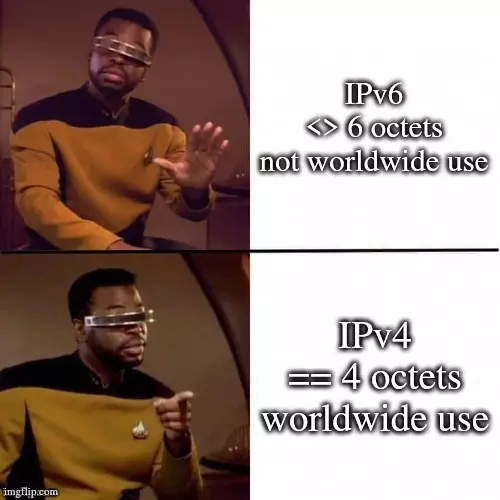It's easier to remember the IPs of good DNSes, too.
It's easier to remember the IPs of good DNSes, too.


Today in our newest take on "older technology is better": why NAT rules!
You're viewing a single thread.
Bro used <> instead of !=
57 0 ReplyWhat languages use this? I don't like it!
On the other hand it goes well with >= and <=. If >= means "either > or =" then <> means "either < or >", it checks out.
But I still don't like it.
18 0 ReplyBASIC. At least VB.
8 0 ReplyI think Excel formulas also use this, but it's been a long time so I might be misremembering.
6 0 ReplyCan confirm also BASICA, GWBASIC, QBASIC, and QuickBASIC
3 0 Reply
SQL
7 0 ReplyDepends on the dialect. I mostly use Presto and MySQL at work, and both allow
!=.Presto also lets you use
NOTfor booleans - instead ofWHERE foo = false, you can doWHERE NOT foo.1 0 Reply
SQL uses it but yeah, not programming language :p.
I was on mobile so I didn't have a
.XComposeavailable to type≠.8 2 ReplyIf you want to be able to write practically anything on mobile, including ≠, ≈, ‰, ℝ etc., have a look at Unexpected keyboard. No spellcheck or autocomplete, though.
5 0 ReplyI was on mobile so I didn't have a
.XComposeavailable to type.I feel the opposite. On mobile I have much easier access to special characters. I just need to hold down characters to get more variants.
2 0 ReplyYup, ≠ is right “under” =. As is ≈.
1 0 Reply
SQL is definitely a programming language. Most dialects are Turing-complete in some way. Some allow custom functions and stored procedures.
2 0 Reply
Damn I never understood it but now it makes sense thanks to you
Yea it’s ugly 😭
3 0 ReplyF# definitely and maybe Haskell and OCaml as well? Elixir and Erlang use it as a binary concatenation operator.
2 0 ReplyYes for OCaml. Haskell's inequality is defined as
/=(for ≠).<>is usually the Monoidmappendoperator (i.e. generalized binary concatenation).3 0 Reply
logo does
2 0 Reply